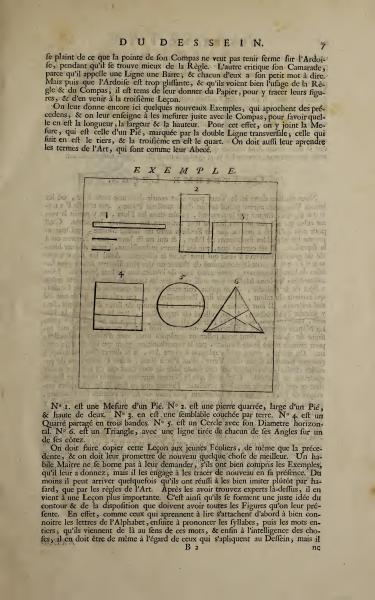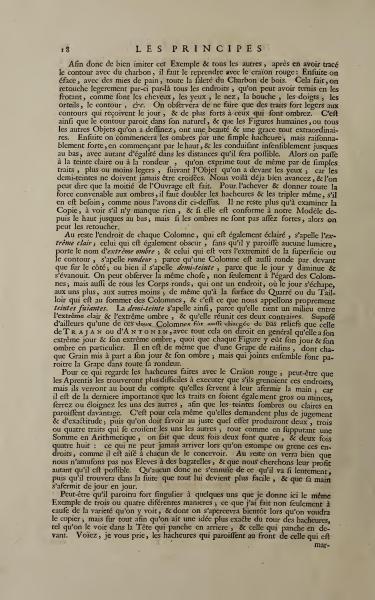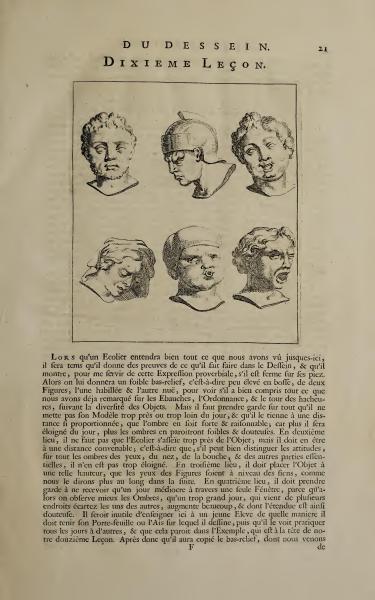| Title | Image | Summary of text |
|---|---|---|
| Lairesse - School of the Art of Drawing | ||
| Lairesse - New School - Page 1 |  | |
| Lairesse - New School - Page 2 |  | The text explains the author's approach to presenting an art treatise, emphasizing simplicity and clarity over elaborate language. The author reflects on the challenge of capturing the vastness of art, aiming to make the guide accessible and beneficial. Despite potential criticism, the author remains committed to offering insightful guidance to those seeking to advance their artistic skills. |
| Lairesse - New School - Page 3 |  | The author expresses gratitude for divine assistance in his work and acknowledges that while his style may be criticized as simple or childish, it is meant to be useful to its intended audience. He argues that simplicity can be more effective than elaborate styles in reaching young minds. The author emphasizes the educational value of the booklet in introducing the principles of fine arts and indicates future works may follow. |
| Lairesse - New School - Page 4 |  | The text discusses the foundational importance of geometry in learning the art of drawing. It outlines a structured approach to mastering drawing, starting with basic principles and progressing through different stages of learning over time. Emphasis is placed on learning under a skilled master and maintaining dedication to truly succeed in the art. |
| Lairesse - New School - Page 5 |  | The text provides an example of basic line principles for art students, emphasizing both theoretical understanding and practical application. It advises teachers on recognizing students' talents through basic exercises and stresses the importance of early practice and patience. The guidance encourages a balanced teaching approach, avoiding extreme leniency or strictness, using gentle instruction to better impact students. |
| Lairesse - New School - Page 6 |  | The text emphasizes the importance of patience in teaching art, gradually instructing young students while highlighting the value of brief and frequent explanations. It advises against pushing students into art forms they dislike, as enjoyment fosters learning more effectively. Demonstrations and gentle corrections are encouraged to inspire students and improve their skills progressively. |
| Lairesse - New School - Page 7 |  | The text describes a series of geometric exercises using basic shapes like circles, squares, and triangles, intended to teach young students principles of drawing with compasses and rulers. It stresses practice in drawing various line orientations like perpendicular and horizontal and promises rewards for skill improvement. The instructions aim to motivate students by promising more intricate patterns to draw once basics are mastered. |
| Lairesse - New School - Page 8 |  | The text is a lesson on basic drawing principles, focusing on the use of tools like the compass and ruler. It provides examples with geometric shapes and guides students through measuring and drawing accurately. The text emphasizes understanding through practice and draws a parallel to learning to read in stages. |
| Lairesse - New School - Page 9 |  | The text discusses the proper approach to teaching art, emphasizing the need for inspiring instruction rather than harsh discipline. It argues that students, like children, need gentle guidance to explore their talents and that skilled masters play a crucial role in a pupil's development. Nature and Art are portrayed as complementary forces in artistic education, and aspiring artists are encouraged to start with simple subjects before tackling more complex ones. |
| Lairesse - New School - Page 10 |  | The text lists common objects such as a beer jug, wine glass, and apple, illustrating how they can be reduced to simple shapes for drawing practice. It emphasizes learning to draw these basic forms as they contain all the necessary linear elements for more complex art. Mastering these helps in achieving bold and accurate strokes, crucial for both sketching and finishing pieces. |
| Lairesse - New School - Page 11 |  | The text introduces basic principles for achieving precision and boldness in drawing, using a diagram as a teaching aid. Important concepts like parallel lines, horizon, and visual rays are discussed to help students understand and correctly apply perspective. The method emphasizes clarity and accuracy, using structured examples to prevent confusion and enhance learning. |
| Lairesse - New School - Page 12 |  | The text discusses the importance of remembering and distinguishing different lines in drawing, emphasizing how engaging with prints by renowned masters can inspire students. It stresses the educational value of separating prints and defined figures in different books to better direct student learning. The author argues for the benefits of learning from drawings made by masters and suggests that students should be encouraged with examples that ignite their imagination and drive toward perfection in art. |
| Lairesse - New School - Page 13 |  | The text discusses the importance of patience and structured learning in art, suggesting that young students must be trained and equipped gradually with skills like handling a brush. It argues against the perception that focusing only on art could shame children, insisting instead on art's utility in shaping judgment and tranquility. Additionally, it posits that the pursuit of art complements personal virtues like temperance and wisdom, often exceeding in value beyond material wealth. |
| Lairesse - New School - Page 14 |  | The text highlights the importance of a lively spirit in the mastery of art, emphasizing that renowned artists like Raphael and Leonardo da Vinci were full of vivacity. It stresses the significance of education as the foundation of society, guiding individuals beyond personal interests to public good. The piece warns against neglecting virtues and sciences in favor of luxury and excess, advocating for proper education and upbringing. |
| Lairesse - New School - Page 15 |  | The text discusses the importance of deep understanding and thorough training in drawing to properly judge art. It warns against purchasing art based solely on superficial qualities like colors, and emphasizes the value of correctly holding tools like charcoal and pencils for sketching. Finally, it highlights the importance of sketching well, observing distances, and practicing accuracy as key aspects of mastering drawing. |
| Lairesse - New School - Page 16 |  | The text provides a guide for drawing two objects by dividing them into parts and marking lines at different heights with charcoal. It stresses the importance of geometry in ensuring accuracy, outlining a method for tracing figures step by step. The emphasis is on methodical drawing rooted in precise geometric principles. |
| Lairesse - New School - Page 17 |  | The text explains how to accurately copy the illustrated examples of human anatomy, focusing on the proportions of the face, hands, and feet. It describes the specific measurements and distances between features like the eyes, nose, and mouth, emphasizing regular proportionality in both men and women. Additional examples of individual features are provided for further practice and understanding of drawing techniques. |
| Lairesse - New School - Page 18 |  | The text instructs students on enhancing their drawings by adding depth with shadows to create solid-looking bodies. Emphasizing technique, it advises using a red pencil and clear hatching without blending. The lesson provides examples of correct pencil handling, stressing careful and patient practice over hasty execution. Philosophers are quoted to highlight the importance of attention and restraint in drawing. |
| Lairesse - New School - Page 19 |  | The document provides instructions on how to refine charcoal drawings using red pencil and erasing techniques to achieve natural shading and outlines. It discusses the use of hatching to create light and shadow variations, ensuring neither overpowers the sketch. The text emphasizes accurate, consistent strokes and understanding the interplay of light, shadow, and the form for effective drawing. |
| Lairesse - New School - Page 20 |  | The excerpt discusses varying techniques for artistic hatching and emphasizes the importance of both hatching and contour in artwork. It introduces a ninth lesson, focusing on drawing whole figures, suggesting methods for structuring figures using charcoal with precise strokes. Students are advised on the benefits of careful observation before beginning their drawings. |
| Lairesse - New School - Page 21 |  | This section of the text from 'Les Principes' discusses the importance of understanding the spatial relationships between different parts of a figure, particularly in drawing. The author advises students to start with basic measurements using a central line and sketch major parts to ensure correct proportions. Emphasis is also placed on maintaining the spirit and natural movement in figures during the sketching process. |
| Lairesse - New School - Page 22 |  | The text outlines a lesson in drawing where students are instructed in creating bas-reliefs with two figures, emphasizing proper techniques in lighting and positioning. It provides guidance on maintaining a suitable distance from the model and ensuring the object's height aligns with the artist's eye level. The lesson stresses understanding the light's impact on shadows, promoting a methodical approach to drawing and shading. |
| Lairesse - New School - Page 23 |  | The text, described as the Eleventh Lesson, suggests methods for mastering drawing with white and black chalk on colored paper. It emphasizes gaining proficiency through imitation of highlighted drawings. The passage conveys the importance of practice and habit in achieving mastery in drawing. |
| Lairesse - New School - Page 24 |  | The text advocates investing in art-related resources, such as engravings and books, urging true art enthusiasts to commit fully to mastering the craft. It provides guidance on sketching a smiling face, emphasizing methodical progression through facial features while maintaining optimal light distribution. The passage concludes encouragingly, suggesting that mastering plaster figures is a key step before advancing to drawing from life. |
| Lairesse - New School - Page 25 |  | The text instructs students on maintaining correct posture and distance when drawing to view objects effectively. It emphasizes the importance of practicing proportion assessment and encourages parents or tutors to find proficient teachers for their children to succeed. The instructions are accompanied by diagrams demonstrating positioning and eye alignment. |
| Lairesse - New School - Page 26 |  | |
| Lairesse - New School - Page 27 |  | |
| Lairesse - New School - Page 28 |  | |
| Lairesse - New School - Page 29 |  | The image contains labels A, B, and C associated with the illustrations. The labels likely indicate different viewpoints or stages in the drawing process. The focus is on demonstrating proportions and detailing in head illustrations. |
| Lairesse - New School - Page 30 |  | |
| Lairesse - New School - Page 31 |  | |
| Lairesse - New School - Page 32 |  | |
| Lairesse - New School - Page 33 |  | |
| Lairesse - New School - Page 34 |  | |
| Lairesse - New School - Page 35 |  | |
| Lairesse - New School - Page 36 |  | |
| Lairesse - New School - Page 37 |  | |
| Lairesse - New School - Page 38 |  | |
| Lairesse - New School - Page 39 |  | The text consists of labels 'A' and 'B' which likely annotate the images. The drawings depict detailed anatomical views of a human back. These annotations seem to relate to teaching the structure of muscles. |
| Lairesse - New School - Page 40 |  | |
| Lairesse - New School - Page 41 |  | |
| Lairesse - New School - Page 42 |  | |
| Lairesse - New School - Page 43 |  | |
| Lairesse - New School - Page 44 |  | The image features a letter 'A', which could be a reference label for the anatomical illustrations. It does not contain additional textual content beyond this label. |
| Lairesse - New School - Page 45 |  | This page includes the number '22' and primarily presents illustrations for artistic study. It features two sets of figures showing young children, moving from simple outlines to detailed drawings, illustrating a methodical approach to figure drawing. |
| Lairesse - New School - Page 46 |  | |
| Lairesse - New School - Page 47 |  | |
| Lairesse - New School - Page 48 |  | |
| Lairesse - New School - Page 49 |  | There is no text to summarize in this image, only a detailed illustration of a human figure from Gérard de Lairesse's book. |
COPYRIGHT © 2024 STUDY DRAWING. ALL RIGHTS RESERVED.